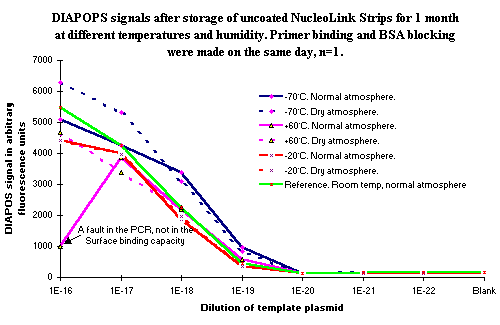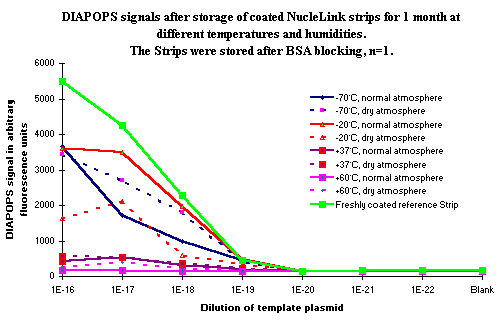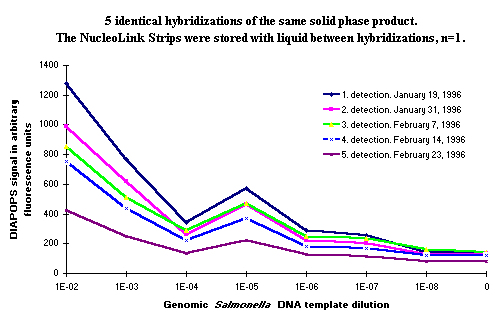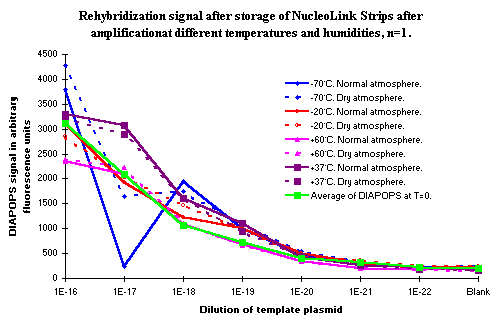The interest in storage time is mostly related to the NucleoLink Strips already coated with a solid phase primer
1. Introduction
The interest in storage time is mostly related to the NucleoLink Strips already coated with a solid phase primer ![]() )
)
If the NucleoLink Strips can be stored for a long time after coating without losing the solid phase primers, or the annealing ability of these solid phase primers, binding of the phosphorylated solid phase primer ![]() )
)![]() )
)![]() )
)
2. Storage of uncoated NucleoLink Strips
There is a possibility that the uncoated NucleoLink Strips may be exposed to both very high and very low temperatures during shipment. To test if these extreme temperatures affect the DIAPOPS results ![]() )
)
 Figure 1: Showing DIAPOPS results in NucleoLink Strips stored for 1 month at different temperatures and humidity. |
3. Storage of coated NucleoLink Strips
The ability to store coated NucleoLink Strips has been analyzed, with DIAPOPS ![]() )
)![]() )
)
3 a). Direct hybridization detection data after long-term storage at 4ºC of NucleoLink Strips coated with various solid phase primers.
The use of direct hybridization detection ![]() )
)![]() )
)![]() )
)
3 b). PCR and DIAPOPS results after long-term storage of coated Strips at 4ºC
In order to see how the DIAPOPS results ![]() )
)![]() )
)![]() )
)
It is likely that the higher liquid phase PCR product concentration in the old Strips compared to the freshly coated NucleoLink Strips is caused by the difference in the amount of active solid phase primers. If less product is synthesized on the solid phase, more will be present in the liquid. However, this hypothesis remains to be further investigated experimentally.
3 c). Accelerated storage experiment without BSA blocking before storage
Coated NucleoLink Strips were tested in an experiment with a storage time of one month at extreme temperatures ranging from -70ºC to +60ºC. The Strips were stored either with a drying agent or in a normal atmosphere. DIAPOPS was performed using the Strips after this storage and compared to a freshly coated reference Strip.
The results presented in Figure 4 show that it is possible to store coated NucleoLink Strips for one month at -20ºC and at -70ºC without any loss in DIAPOPS performance. At +37ºC, the performance is significantly reduced, but the results are still clearly positive. After storage of one month at +60ºC the solid phase DNA amplification is almost non-existant.
Data from the results illustrated in Figure 4 demonstrates that it is possible to store the coated NucleoLink Strips at 37ºC for one month and get positive results, although the performance is reduced. There is no difference between the DIAPOPS results from Strips stored under dry conditions and from Strips stored in a normal atmosphere.
3 d). Accelerated storage experiment with BSA blocking before storage
An experiment identical to the one presented in Figure 4 was performed, but with NucleoLink Strips coated with the solid phase primers and blocked with BSA before storage. The results from this experiment are presented in Figure 5.
 Figure 5: DIAPOPS analysis of BLV plasmid. The analysis was made on NucleoLink Strips stored after coating and blocking with BSA at different temperatures, both with and without drying agent. The green bar represents the freshly coated and blocked reference Strip. |
The results in Figure 5 clearly indicate that it is not feasible to store the coated NucleoLink Strips after blocking with BSA. At +37ºC and +60ºC there is no hybridization signal, and even after storing at -70ºC the signal is decreased. Since there is no association between the results from Strips stored with and without drying agent, one can conclude that the presence of a drying agent does not influence the result when the coated Strips are stored after BSA blocking.
4. Storage of NucleoLink Strips after PCR with immobilized amplicons
The solid phase amplicons are still attached to the surface after a positive DIAPOPS analysis. Therefore, they can be detected again by rehybridization ![]() )
)![]() )
)
4 a). Storage with liquid
After removal of the detection probe ![]() )
)![]() )
)
 Figure 6: DIAPOPS results from 5 identical hybridizations of the same solid phase product. The NucleoLink Strips were stored with liquid between the hybridizations. It is clear that the signals are decreasing, and it can be concluded that the NucleoLink Strips should be stored empty between the hybridizations. Figure 6: DIAPOPS results from 5 identical hybridizations of the same solid phase product. The NucleoLink Strips were stored with liquid between the hybridizations. It is clear that the signals are decreasing, and it can be concluded that the NucleoLink Strips should be stored empty between the hybridizations. |
It is clear that the signals are decreasing, and the samples with the lowest template concentration become negative after the third rehybridization.
4 b). Storage without liquid
Data from a rehybridization of solid phase products after storage for one month at different, extreme temperatures are presented in Figure 7. The results are identical to those from the first detection before storage, both in level of signal and limit of detection. From the results of the analysis of the stored, coated NucleoLink Strips it was expected that some decrease in signals would be seen. The reason this decrease in signal is not seen is probably a combination of a very small degradation of the solid phase product, and a difference in hybridization efficiency between the experiments ![]() )
)
 Figure 7: DIAPOPS results from an analysis of a dilution series of BLV template plasmid DNA. The results are from rehybridizations of Strips stored at different temperatures and humidity after the solid phase DNA amplification. The green bar shows the results from the analysis before storage (T = 0). It is clear that no significant difference can be seen after the storage. Figure 7: DIAPOPS results from an analysis of a dilution series of BLV template plasmid DNA. The results are from rehybridizations of Strips stored at different temperatures and humidity after the solid phase DNA amplification. The green bar shows the results from the analysis before storage (T = 0). It is clear that no significant difference can be seen after the storage. |
The results presented in Figure 7 indicate that after amplification the solid phase product is stable, can be stored for a prolonged time, and still be detected with good reproducibility.
5. Conclusion
The uncoated NucleoLink Strips can be stored at normal temperatures for a very long time, and they show no decrease in performance when stored at either -70ºC or +60ºC for one month.
The coated NucleoLink Strips are stable at 4ºC for at least 10 months. After this period of time, a decrease may be seen with some solid phase primers. After storage of the coated Strips for one month at 37ºC, the DIAPOPS results are reduced, but still clearly positive.
Storage is not recommended if the Strips are blocked with BSA before storage as the DIAPOPS signals will strongly decline. Even at -70ºC, a significant decrease in signals can be seen after one month of storage.
The solid phase PCR product is very stable after the DNA amplification. The Strips may be stored for a prolonged time, and still be detected with good reproducibility ![]() )
)
In this series of experiments, storage was tested both in a dry atmosphere, provided by adding a drying agent to the sealed ethylene bag in which the NucleoLink Strips were stored, and in a normal atmosphere in unsealed polyethylene bags. There was no difference in any of the experiments between the results from the Strips stored dry and from those of the Strips stored in a normal humidity. It is therefore not necessary to store the coated NucleoLink Strips in a dry atmosphere.